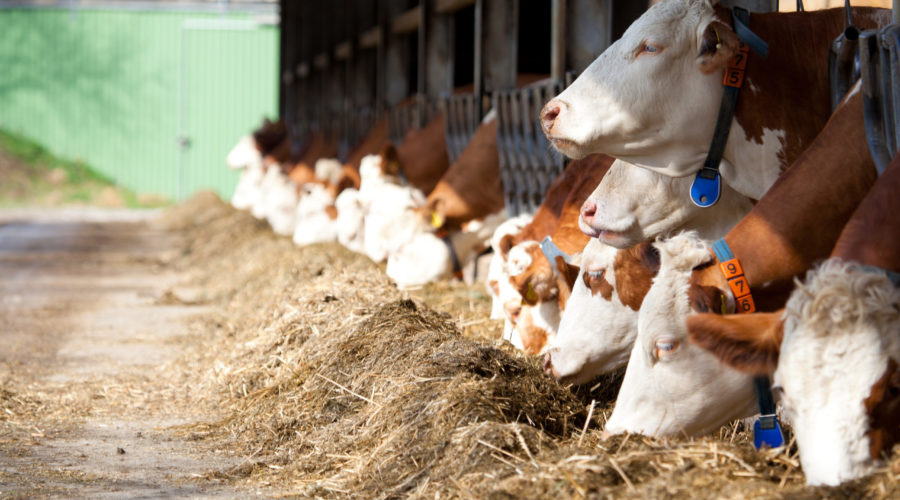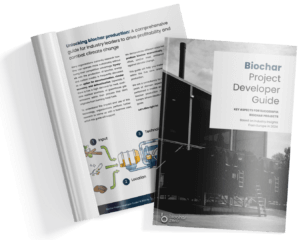Due to its sponge-like structure, biochar can be used effectively to increase animal health and improve the indoor climate in agriculture. Biochar is already used as an additive in the feed of a wide range of farm and domestic animals.
Advantages of Biochar in Animal Feed
- Reduction of medication and doctor’s visits
- Prevention and alleviation of digestive problems and gastrointestinal complaints, improved blood values
- Elimination of toxins such as pesticides or mycotoxins
- Improved feed conversion, weight gain and meat quality
- Improved barn climate due to reduced ammonia emissions and other greenhouse gases, thus increased well-being for employees and animals 1 Schmidt H, Hagemann N, Draper K, Kammann C. (2019), The use of biochar in animal feeding. PeerJ 7:e7373. https://doi.org/10.7717/peerj.7373
The slurry and manure enriched with biochar can and should be reused, for example in arable farming. Biochar acts as a carrier material for nutrients and, among other things, increases the effectiveness of slurry. This creates a cost-neutral second use. This is referred to as the cascade use of biochar. For more benefits of using biochar enriched manure in the field, see the [Soil biochar knowledge page link].
Biochar causes long-term and stable carbon storage, which means that the use of biochar in agriculture leads to the formation of negative emissions and CO2 sink certificates (CO2 Removal Certificate, CORC) can be sold.
State of Development
Feed biochar is one of the most developed and well-tested products made from biochar. Development has progressed to the extent that biochar feed additive preparations customised to the animal species are already available.
In Switzerland, the addition of biochar to the feed of livestock farms has become widely accepted in the last decade due to its enormous benefits and cascade use. In other European countries, the use of biochar feed for livestock and domestic animals is still far less widespread, but is gaining in importance.
Usage
The form in which biochar feed additive is applied depends on the respective animal species, meaning that there are different variants. Feeding biochar is mostly used as powder in wet feed or as pellets in dry feed. For targeted use, the biochar must be carefully selected, as each biochar is different due to the raw materials and the way it is produced. Configured biochar feed mixtures can vary in particle size, moisture and raw material.
Dose for different animals
For the dosing of the feed biochar, the following recommendations are given by the common suppliers depending on the animal species:
| Animal type | Dose per body weight & day | Dose per animal feed weight |
|---|---|---|
| Cow | 0,4 kg / t weightpreventive: 0,1 kg / t | 2 – 5 kg / t animal feed |
| Calf | 0,1 bis 0,2 kg / t weightbzw. vorbeugend: 0,1 kg / t | kg / t animal feed |
| Pig | kg / t weight | 0,8 – 5 kg / t animal feed |
| Horse | 0,1 – 1 kg / t weight | 1 kg / t animal feed |
| Poultry (small domestic animals) | 0,1g – 2g / per animal (25g – 5 kg) (1 Prise) | 1,5 bis 5 Kg / t animal feed |
| Dog | 0,1 g / kg weight | 1 bis 2 g / day |
| Cat | 0,1 g/ kg weight | 1 bis 2 g / day |
| Rodent | 0,1g – 1g / 25 – 50g |
Biochar feed additives can be dosed on the basis of the animal’s own weight or on the basis of the feed weight. Young animals receive about a quarter to half of the dose for adult animals. Biochar in feed can be used both as a preventive measure and for acute needs, such as gastrointestinal complaints.
If an animal is ill, the daily dose can be increased by 50 % for a few days. During the administration of medication, no biochar feed additives should be added, as the biochar partially binds the active ingredient of the medication, or the dosage should be clarified with medical professionals.
Approval & Certification
Feed biochar is subject to strict testing guidelines. Within the certification system of the European Biochar Consortium (EBC), the EBC feed certification is required for biochar feed additives.
In the EU, biochar is authorised as a feed material on the basis of EU Regulation 68/2013 as a “product obtained by carbonisation of plant mass”.2EU-Komission (2013) VERORDNUNG (EU) Nr. 68/2013 DER KOMMISSION vom 16. Januar 2013 zum Katalog der Einzelfuttermittel, TEIL C Verzeichnis der Einzelfuttermittel, aufgerufen am 12.Juli 2022 von https://eur-lex.europa.eu/legal-content/DE/TXT/PDF/?uri=CELEX:32013R0068 As long as the limits described in Regulation (EC) No 178/2002 are complied with, the biochar feed additives can also be spread in EU countries without EBC certification.

vom 16. Januar 2013 zum Katalog der Einzelfuttermittel, TEIL C Verzeichnis der Einzelfuttermittel, Aufgerufen am 12.Juli 2022 von https://eur-lex.europa.eu/legal-content/EN/TXT/PDF/?uri=CELEX:32013R0068
If biochar is to be administered via feed, it is mandatory to use a tested and certified char. For feed biochar, however, there are different certifications than in the food supplement sector. In order to prove quality, the international feed certification GMP+ has become widespread, or a QS standardisation is used among the biochar-producing companies.4GMP+, Aufgerufen am 20.Juli 2022 von https://www.gmpplus.org/de/feed-certification-scheme/
In Austria there is also the AMA Pastus+ certification, for which biochar products can be approved. In Switzerland, where biochar feed additives has already been approved since 2013, the feed biochar must comply with the requirements according to the Feedstuffs Regulation (Futtermittel-Verordnung, FMV) and the Feed Book Regulation (Futtermittelbuch-Verordnung, FMBV)526.07.2022
https://charnet.ch/nicht-jede-kohle-darf-in-den-boden/.
The use of biochar feed additives in organic agriculture has been authorised in Austria since 2018 and in the EU since January 2020. Previously, it was only possible to use FiBL-listed products in organic farming. This possibility still exists. However, not all organic associations explicitly support the use of biochar. Under the Demeter label, the use of biochar is only permitted as a composting aid in the form of organic fertiliser and as mulch material since January 20226Demeter (2022), RICHTLINIEN 2022,
Erzeugung und Verarbeitung Richtlinien für die Zertifizierung »Demeter« und »Biodynamisch«. GÜLTIG AB 01. JANUAR 2022. Aufgerufen am 20.Juli 2022 von https://www.demeter.de/sites /default/files/richtlinien /richtlinien_gesamt.pdf#page=91.


Picture credits:
©Depositphotos/KarepaStock (Foto-ID: 237501858)




